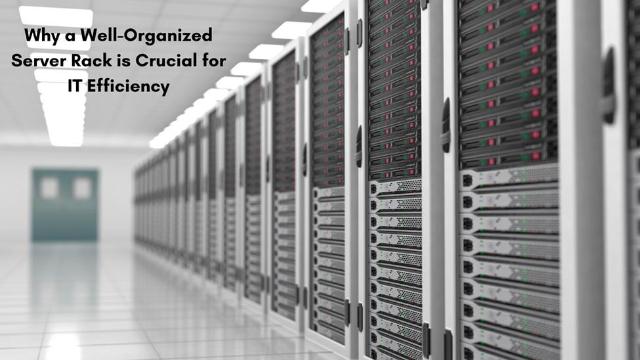Why a Well-Organized Server Rack is Crucial for IT Efficiency
In today's digital age, the backbone of any successful business lies in its IT infrastructure. At the heart of this infrastructure lie server racks, the unsung heroes of data centers worldwide. But why is a well-organized server rack so crucial for IT efficiency? Let's explore the significant impact proper rack organization can have on your entire IT operation.
The Foundation of IT Infrastructure
Server racks are more than just metal frames holding equipment. They're the foundation of your IT infrastructure, housing critical components that keep your business running smoothly. A well-organized server rack optimizes performance and reliability while setting the stage for future growth.
Enhanced Airflow and Cooling Efficiency
One of the most critical aspects of server rack organization is its impact on airflow and cooling. Proper airflow is essential for maintaining the right temperature for servers and networking equipment. Here's why it matters:
Proper cooling prevents overheating, which can reduce performance and increase the risk of hardware failure. Efficient cooling helps prolong the lifespan of your equipment. Consistent temperature regulation is crucial, especially in larger setups using a 4U server chassis, to ensure reliable performance.
Studies show that server racks with efficient cooling mechanisms, such as built-in fans and optimized airflow designs, can significantly reduce energy consumption.
Simplified Maintenance and Troubleshooting
A well-organized server rack is invaluable to technicians. When every cable is in its place and every piece of equipment is easily identifiable, maintenance becomes a breeze. Benefits of organized racks:
- Reduced downtime during upgrades or repairs
- Quicker identification and resolution of issues
- Lower risk of human error during maintenance
IT professionals agree that properly routing and labeling cables prevents accidental disconnections. This organization can significantly reduce troubleshooting time by up to 50%.
Improved Accessibility and Risk Reduction
Safety should never be an afterthought in IT infrastructure management. A well-organized server rack contributes significantly to a safer work environment. Safety improvements:
- Reduced tripping hazards from loose cables
- Prevention of accidental unplugging
- Easier access during emergencies or critical maintenance
Easy accessibility to equipment is crucial for swift installations, repairs, and upgrades. Organized racks can reduce the time required for routine maintenance by up to 30%.
Scalability and Future-Proofing Your IT Infrastructure
As your business grows, so do your IT needs. A well-organized server rack is not just about managing current requirements; it's about preparing for future expansion. Scalability in IT infrastructure is crucial for businesses to remain competitive and responsive to changing market demands. Tips for future-proofing:
- Choose larger server racks (e.g., 48U) for room to grow
- Plan cable management with future additions in mind
- Document your setup for easier upgrades
Strategies for Future-Proofing
A well-organized server rack provides the foundation for scalable growth, allowing your IT infrastructure to evolve seamlessly with your business needs. By implementing strategic planning, you can create a flexible system that adapts to future challenges.
- Choose Larger Server Racks: Opt for racks with extra space, such as 48U racks. This provides room for additional servers, networking equipment, and storage devices as your needs expand.
- Modular Design: Implement a modular approach to your rack setup. This allows for easier addition or replacement of components without disrupting the entire system.
- Cable Management with Growth in Mind: Plan your cable management system to accommodate future additions. Use solutions that can be easily expanded or reconfigured.
- Power and Cooling Considerations: Ensure your power distribution units (PDUs) and cooling systems have capacity beyond your current needs. This prevents the need for major infrastructure changes as you add more equipment.
- Documentation and Labeling: Maintain detailed documentation of your current setup and label all components clearly. This makes future modifications and troubleshooting much more efficient.
- Standardization: Standardize your hardware and software configurations as much as possible. This simplifies management and makes it easier to scale horizontally.
Cost Efficiency and Smart Asset Management
Efficient rack organization represents a crucial aspect of prudent financial management in IT operations. A meticulously organized server rack can result in substantial cost savings and enhance asset management efficiency, directly influencing your company's financial health. Some of the cost-saving benefits include:
- Extended equipment lifespan due to better cooling
- Reduced energy consumption
- Lower maintenance costs
Server racks equipped with integrated cable management features can enhance airflow efficiency, leading to reduced cooling costs.
Conclusion
Investing time and resources into properly organizing your server racks is a strategic move that can lead to significant long-term benefits for your organization.
Remember, a well-organized server rack is an investment in your IT infrastructure's future. By implementing these best practices, you're not just tidying up - you're optimizing performance, enhancing safety, and setting the stage for scalable growth. Take the time to organize your racks today and reap the benefits for years to come.
FAQs
1. What are the best practices for organizing a server rack?
Use vertical and horizontal cable management, implement proper labeling systems, and follow manufacturer guidelines for equipment placement. Regular audits and maintenance schedules also play a crucial role in keeping your racks organized.
2. How often should server racks be reorganized or audited?
It's recommended to perform a thorough audit of your server racks at least twice a year. However, you should reorganize as needed, especially after major upgrades or changes in equipment. Regular checks can prevent small issues from becoming big problems.
3. Can server rack organization impact compliance with IT standards?
Absolutely. Proper server rack management can help meet various IT standards and regulations related to data security and infrastructure integrity. Well-organized racks make it easier to demonstrate compliance during audits and ensure that security measures are properly implemented.

